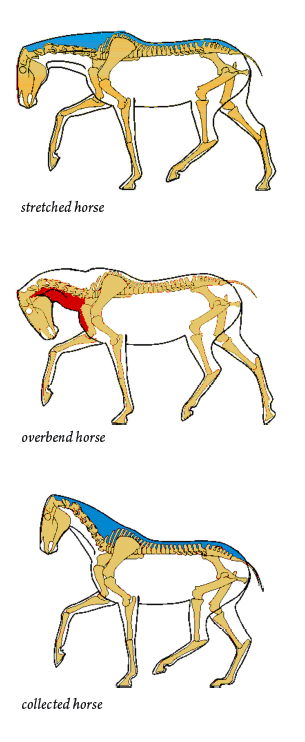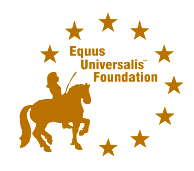Text by Josepha Guillaume
Horses have more weight at the front than at the back because of the weight of the head and neck. For some reason the front legs are not equipped as shock absorbers because of the way they are built.
The hind legs however can bend like an accordion and can function for the horse like the suspension does for a car. It looks like nature has made a mistake by putting the suspension at the hind end, while most of the weight is in the front. But as always, she has not. Nature has evolved a way for horses to absorb any shocks and weight with the hind quarters, even though it is the head that goes down.
 This system is based on the horses stretching the neck – for instance while they are grazing. When the horse stretches the neck and head forward and down this pulls on a ligament which attaches the base of the horses skull to the withers. This ligament is called the nuchal ligament or neck-back band. When this ligament is stretched, the muscles on the top of the neck are activated and the withers are lifted up, at the same time lifting the ribcage.
This system is based on the horses stretching the neck – for instance while they are grazing. When the horse stretches the neck and head forward and down this pulls on a ligament which attaches the base of the horses skull to the withers. This ligament is called the nuchal ligament or neck-back band. When this ligament is stretched, the muscles on the top of the neck are activated and the withers are lifted up, at the same time lifting the ribcage.
As a result, the longissimus or the long back muscles become free to do that for which they are designed: dictate the locomotion within the horse. Because of the lifted ribcage and the free movement of the long back muscles, the pelvis has a lot of room to rotate backwards and with that bring the hind legs further under the body. This makes the hind legs bend more and take up more of the body weight. The shoulder then has a lot more freedom for the front legs to step forward, away from the body, thus putting weight upon them is minimised.
In conclusion, when we as riders activate or simply maintain this natural ‘back-stretch’ system born within every horse, we have found an easy way to spare the front legs, keep the back healthy and teach the hind quarters to take up weight and consequently bend, which will ultimately lead to collected movement.
A horse that is able to use this system to keep it’s body sound has a naturally arched neck with lots of muscles on the top line. From above, the neck looks larger at the base and smaller at the head.
What can interfere with this ‘back-stretch’ system?
Several things can interfere with this back-stretch system. One of the problems that can occur is when a rider does not follow the movement of the horse’s back with his seat or pushes against the horse’s back. As a result, the horse’s head will go up, because the back has dropped. A bad fitting saddle can also cause the horse to be unable to use the long back muscles and bring the back up.
Interfering rein action is another common cause that renders the back stretching system unable. To keep their balance, all animals need their completely free range of head and neck movement. If this movement is restricted or prevented then, it is registered in the brain by means of the vestibular system. This system is responsible for maintaining the balance in most mammals and works using information received from the movement of head and neck, which work as a sort of cantilever.
If the vestibular system notices that the head and neck movement is restricted or stuck, the brain will send out messages to let the body act in a way that will prevent toppling over or falling. Reflex action triggers the horse to activate the lower muscles of the neck. These so-called neck flexors, will prevent the body from toppling over or the horse falling on to his knees, which, if you are a prey animal, is of course always a good thing. It means you can keep walking and running, even though your body is not functioning properly.
The lower neck muscles and the top neck muscles are antagonistic. This means that when one muscle (group) is working, the other one is not. So, when by rein action, the lower neck muscles are active for the reasons explained above, the upper line is not. When this happens the back-stretch system is inactive and the hind quarters can no longer serve as shock absorbers. Consequently, the front legs will get the full blast of each stride. As they are not equipped to handle this impact, the front legs will be prone to injury in due course. As the long back muscles can not activate correct locomotion and the hind legs can not step forward from the pelvis sufficiently, the back, spine, lumbar region and pelvis will suffer injury as well, over a period of time.
To see whether your horse uses his neck and therefore his cantilever system correctly look at your horse’s neck when in the saddle. If the neck does not look as described above, your horse is moving in a harmful way.
Collection
For collected movement, the back-stretch system will build enough strength in the top line and flexibility in the hind quarters for the horse to carry his own weight and subsequently that of the rider.
Through transitions from the seat the horse will start ‘sitting’ behind while the top line will raise the horse in the front. For this system the ultimate balance is needed, thus here too, the horse needs the full range of movement of head and neck to keep his balance with the assistance of the vestibular system.
 This information was offered to you by: the European Equus Universalis Foundation and sponsored by the people handing it out.
This information was offered to you by: the European Equus Universalis Foundation and sponsored by the people handing it out.
If you would like more information, please visit:
www.equusuniversalisfoundation.eu
Heal now prevent for the future
